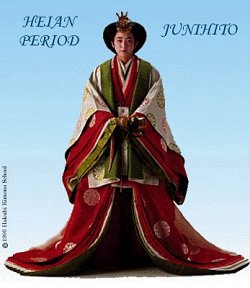October 23, 2005Chapter 7 (12 Kingdoms) The wearing of multiple layers of kimono was haute couture during the Heian Era, with ladies of the court donning a dozen or more layers of kimono of different colors and styles. This ceremonial court dress is called juuni hitoe (十二単衣), literally, "12 layers." Because if its impracticality and wanton excess, it waned in popularity during the military rule of the subsequent shogunates and the rise of the bushidou ethic. The wearing of multiple layers of kimono was haute couture during the Heian Era, with ladies of the court donning a dozen or more layers of kimono of different colors and styles. This ceremonial court dress is called juuni hitoe (十二単衣), literally, "12 layers." Because if its impracticality and wanton excess, it waned in popularity during the military rule of the subsequent shogunates and the rise of the bushidou ethic.玉佩 [おびだま] obidama (nonstandard reading), ornamental jewels worn in the obi or sash of a kimono by the head of state on special occasions. sinecure n. 1. an office or position requiring little or no work, esp. one yielding profitable returns. tad n. informal 1. a small child, esp. a boy. tog n. 1. a coat. 2. Usu., Here, 子 (tad) is being used as a diminutive. So 袍 (coat/clothes) + 子 becomes "tad togs" (word order reversed), or how the elite refer to commoner's dress. 玻璃 [はり] Hari, lit. "crystal glass" 麦侯 [ばくこう] Marquis of Baku 浩瀚 [こうかん] Koukan Kanji that describe clothing often include the koromo radical, a simplification of the kanji for "clothes" (衣). Except for hakama, the following kanji compounds were created by the author. 袴 [はかま] hakama, a divided skirt 袍衫 [ほうきん] houkin, lit. "coat" + "thin kimono" 襦裙 [じゅくん] jukun, lit. "undergarment" + "skirt" 袍子 [ほうし] houshi, lit. "coat" + "child" = "tad togs" 長袍 [ちょうほう] chouhou, lit. "long coat"
Comments: the 袍 (robe) is what both the elite and the commoners use to refer to their own 袍, but separately, the elite call the commoners' 袍, a 袍子 (the 子 acts similar to a diminutive suffix like the "-ette" in cigarette, the "-ling" in duckling or the "-let" in booklet), while the commoners refer to the 袍 worn by the elite as 長袍. your translation seems to reflect this, but the note for "tog" does not. also, why does 襦裙 literally translate to "undergarment"?
i'm sorry if i come off as a nitpicker, but your notes seem to be detailed and meticulously done. i thot perhaps you would want them to be as complete as possible. feel free to disregard these comments as you wish. Good point about the 子 suffix. It is being used here as a diminutive. I've amended my notes accordingly.
WWWJDIC glosses 襦 as "underwear" and the only compound Yahoo lists is 襦袢=和服用の下着 as does Goo 襦袢=an underwear; an undershirt. WWWJDIC also glosses 裙 as "underwear" (and "hem"). Yoshie Omura defines 襦裙 as 女の衣服。襦はブラウス、裙は巻きスカート (skirt). This is in line with Goo: 裙は裙子に同じ=腰から下を覆う (skirt). So a better transliteration would be "undergarment (blouse)" + "skirt." This does make more etymological sense, as a woman is not considered presentable wearing only the blouse and skirt, so the 襦裙 would be beneath the robe or vest worn over it. Thanks for the input. Nitpicking always welcomed. |
